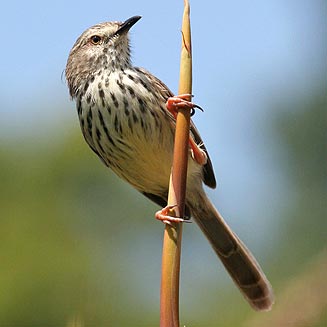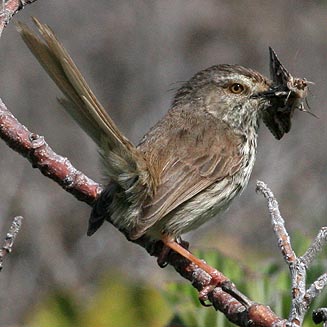|
Prinia maculosa (Karoo prinia,
Spotted prinia)
Karoolangstertjie [Afrikaans]; Ujiza [Xhosa]; Motintinyane
(generic term for cisticolas and prinias), Seqeshe [South Sotho]; Karoo-prinia
[Dutch]; Prinia du Karroo [French]; Fleckenprinie, Gelbbauchprinie [German];
Prínia-malhada [Portuguese]
Life
> Eukaryotes >
Opisthokonta
> Metazoa (animals) >
Bilateria >
Deuterostomia > Chordata >
Craniata > Vertebrata (vertebrates) > Gnathostomata (jawed
vertebrates) > Teleostomi (teleost fish) > Osteichthyes (bony fish) > Class:
Sarcopterygii (lobe-finned
fish) > Stegocephalia (terrestrial
vertebrates) > Tetrapoda
(four-legged vertebrates) > Reptiliomorpha > Amniota >
Reptilia (reptiles) >
Romeriida > Diapsida > Archosauromorpha > Archosauria >
Dinosauria
(dinosaurs) > Saurischia > Theropoda (bipedal predatory dinosaurs) >
Coelurosauria > Maniraptora > Aves
(birds) >
Order: Passeriformes > Family: Cisticolidae
> Genus: Prinia
 |
 |
|
Karoo prinia, Kirstenbosch Botanical Gardens,
Western Cape, South Africa. [photo
Duncan Robertson
©] |
Karoo prinia with moth, Kleinmond, Western Cape, South Africa. [photo Duncan Robertson
©] |
Distribution and habitat
Endemic to southern Africa, occurring from the extreme
south of Namibia to the Northern, Western and Eastern Cape, extending into the
Free State and Lesotho. It is common to locally very common, preferring
shrubland such as fynbos, Karoo scrub and renosterveld but also occupying
gardens, thickets of alien Acacia trees and strandveld.
Brood parasites
It has been recorded as host of the
Diderick
cuckoo and
Brown-backed honeyguide.
Food
It eats a variety of small invertebrates, gleaning them
from the leaves and stems of bushes. The following food items have been recorded
in its diet:
Breeding
- The nest is built by both sexes in about 4-14 days, consisting of an oval
or pear shape with a side entrance, built of woven green grass which turns
light brown over time. A thick lining of plant down or wool is added to it
during incubation. It is typically conceals it in a tuft of spiny grass,
sapling, shrub or bush, occasionally in a garden plant adjacent to a house;
it may even place it in an old
Yellow bishop or Southern red
bishop nest.
- Egg-laying season is from July-January, peaking from August-November.
- It lays 1-5 eggs, which are incubated solely by the female for
approximately 11-17 days.
- The chicks are fed a variety of invertebrates by both parents, leaving
the nest after about 10-14 days.
Threats
Not threatened.
References
-
Hockey PAR, Dean WRJ and Ryan PG 2005. Roberts
- Birds of southern Africa, VIIth ed. The Trustees of the John Voelcker
Bird Book Fund, Cape Town.
|
